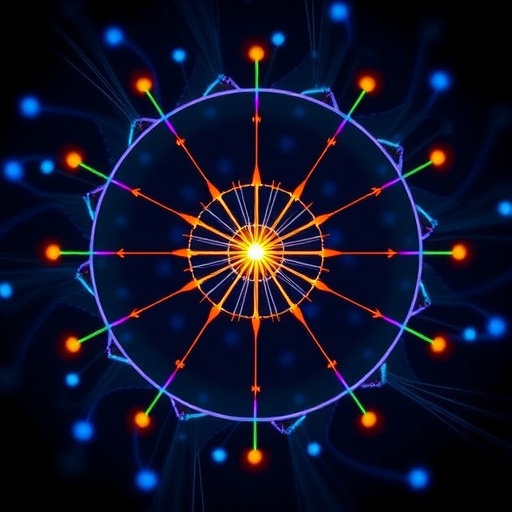
HOUSTON – In recent advances in quantum mechanics, researchers from Rice University, in partnership with collaborators, have unveiled groundbreaking findings regarding phononic quantum interference, a phenomenon that holds significant potential for enhancing the precision of sensors and ultimately transforming the field of quantum computing. Just as ripples created by stones tossed into a calm pond can combine in complex ways, leading to either amplification or cancellation, phononic waves — the quantum vibrational manifestations of heat or sound in materials — can also interfere with each other, creating conditions ripe for exploration and application.
The study, which has been published in the esteemed journal Science Advances, highlights a novel instance of phonon interference, pronouncedly strengthened by the introduction of two-dimensional metallic films atop silicon carbide substrates. Remarkably, this interference mechanism was observed to be two orders of magnitude stronger than previously documented instances, offering compelling evidence of the untapped potentials of phonons in the realm of quantum technologies. The distinctive process of interference under investigation, identified as Fano resonance, allows phonons with disparate energy distributions to influence one another, yielding insights into their quantum mechanical behaviors.
Phonons remain one of the lesser-explored elements within quantum physics, especially when contrasted with the wealth of studies focused on electrons and photons. In fact, close examination reveals that the subtle properties and interactions of phonons could be harnessed to form the foundation for highly durable and performant devices, driving advancements in precision sensing applications. The implications of this research signal a shift in focus toward the fundamental characteristics of phonons, illuminating pathways for integrating these quantum vibrations into practical technologies that extend our current capabilities.
.adsslot_QiKynuoeTp{width:728px !important;height:90px !important;}
@media(max-width:1199px){ .adsslot_QiKynuoeTp{width:468px !important;height:60px !important;}
}
@media(max-width:767px){ .adsslot_QiKynuoeTp{width:320px !important;height:50px !important;}
}
ADVERTISEMENT
Using a meticulous approach termed confinement heteroepitaxy, the team synthesized a unique structure by intercalating a handful of silver atom layers within graphene, establishing a remarkably stable interface with compelling quantum characteristics when combined with silicon carbide. This approach demonstrates how 2D metallic films can serve as catalysts that not only facilitate but indeed enhance the vibrational interference between different phononic modes housed within silicon carbide, achieving unprecedented resonant behavior.
The researchers employed Raman spectroscopy to analyze the phononic interactions further, measuring vibrational signatures across various samples. The Raman spectra displayed a curious asymmetric line shape, occasionally resulting in complete dips that corresponded to classic antiresonance patterns typical of profound interference phenomena. Such fingerprints suggest that the phononic signals are not only sensitive indicators of their environments but also serve as a means for detecting subtle changes in material properties.
To underscore the efficacy of their findings, the team characterized how distinct silicon carbide surface terminations influenced the interference patterns observed. By executing comparative analyses, they could definitively connect specific surface configurations to exclusive Raman characteristics. Interestingly, they found that when interfacing with a singular dye molecule, the scales shifted dramatically, further exemplifying the sensitive nature of phononic interactions and implying potential for single-molecule detection methodologies that leverage these unique interference effects.
What stands out in this research is the group’s success in isolating the phononic interactions from electronic processes, affirming that the observed phenomena were indeed manifestations of phonon-only interference. This distinction elevates the significance of their findings within the scope of quantum physics, providing a rare glimpse into the controlled manipulation of phononic states that could eventually find application in cutting-edge quantum sensing technologies.
As the researchers explored the potential for applying alternative 2D metals such as gallium and indium, they outlined a compelling future trajectory in which they could custom-engineer interfaces tailored for specific quantum process optimizations. This notion suggests vast expanses of exploration in material science that could reshape our understanding and utilization of vibrational mechanics across technologies.
The implications of such findings transcend laboratory curiosities, branching into the fascinating realms of molecular sensing, energy harvesting, thermal management, and quantum technologies. The ability to foster exceedingly sensitive measurements without the necessity for complex chemical labels or intricate device setups proposes a paradigm shift in how we perceive and interact with molecular and atomic phenomena. Such advancements not only enhance existing capabilities but also introduce new paradigms for future technologies that hinge on the manipulation of vibrational states.
In conclusion, utilizing phonons as viable components in next-generation sensing technologies marks an exciting frontier in materials science and engineering. This research propels the conversation forward regarding the roles that nuanced quantum interactions can play in practical applications, asserting the potential of phonons as a central pillar in a world increasingly governed by quantum mechanics. The continuation of this line of inquiry may yield revolutionary advancements in multiple disciplines, ultimately broadening the scope of what is achievable through the lens of quantum innovation.
The study was funded by notable institutions including the National Science Foundation, the Air Force Office of Scientific Research, and the Welch Foundation, underscoring the collaborative nature of this groundbreaking research. The findings encapsulated in this study not only illuminate the promising future of phononic interference in quantum technologies but elevate our understanding of the materials themselves, inviting further exploration into the quantum realm.
Subject of Research: Phononic Quantum Interference Induced by Two-Dimensional Metals
Article Title: Tunable Phononic Quantum Interference Induced by Two-Dimensional Metals
News Publication Date: Aug. 11, 2025
Web References: https://www.science.org/doi/10.1126/sciadv.adw1800
References: nakd
Image Credits: Photo by Jeff Fitlow/Rice University
Keywords
Tags: advancements in quantum mechanicsapplications of phonons in quantum computingenhancing precision of quantum sensorsFano resonance in phononsphonon interference in materialsphononic quantum interferencequantum interference mechanismsquantum vibrational phenomenaRice University quantum researchsilicon carbide substrates in quantum researchtwo-dimensional metallic films in quantum technologyuntapped potentials of phonons





